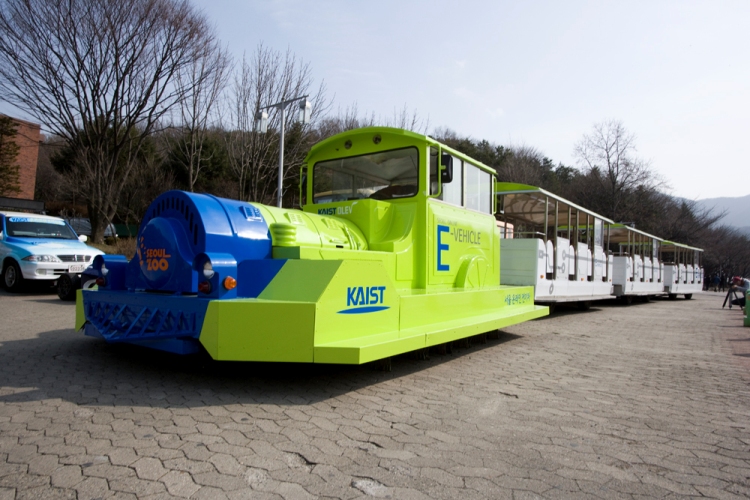people
On September 19, KAIST announced that the electromagnetic (EM) field levels of its online electric vehicle (OLEV) measured in June and September of this year demonstrated verification of its safety.
Last June, the EM field level of OLEV installed at the Seoul Grand Park was measured by the Korea Research Institute of Standards and Science (KRISS) to test its harmfulness to human. The results were 0.5 ~ 61mG which is within the national and international standards of 62.5mG.
KRISS measured EM field levels on 22 spots on the side of and at the center of OLEV at a fixed distance (30cm) but variable heights (5cm~150cm) according to the national standard of measurement methods for electromagnetic fields of household appliances and similar apparatuses with regard to human exposure (IEC 62233).
In addition, another testing took place on September 13 following a request by National Assemblywoman Young-Ah Park, a member of the National Assembly’s Education, Science and Technology Committee, who has raised an issue on the safety of OLEV. This testing session was held by EMF Safety, Inc., an institution designated by Park, and it tested the EM field level of the same OLEV train that was tested in June.
As a result, the September measurements were well within the national and international standards with 0~24.1mG. The test was conducted under the presence of third party to produce a fair and objective result.
As reference, the EM field level results are well within the American IEEE electromagnetic field standards of 1,100 mG.
The September measurements were produced by Park’s recommendation of following the criteria specified in the measurement procedures of IEC 62110, “Electric and magnetic field levels generated by AC power systems to public exposure,” which were 15 measurements at a fixed 20cm distance at the side of and from the center of OLEV with variable heights of 50cm~150cm.

-
people Top 10 Emerging Technologies by World Economic Forum
The World Economic Forum’s Meta-Council on Emerging Technologies announced its annual list of breakthrough technologies, the “Top 10 Emerging Technologies of 2016,” on June 23, 2016. The Meta-Council chose the top ten technologies based on the technologies’ potential to improve lives, transform industries, and safeguard the planet. The research field of systems metabolic engineering, founded by Distinguished Professor Sang Yup Lee of the Chemical and Biomolecular Engineer
2016-06-27 -
people Two Undergraduate KAIST Students Publish a Book on Health Management
Joonho Suh of the Aerospace Engineering Department and Jiho Suh of the Mechanical Engineering Department are both brothers and undergraduates at KAIST. The Suh brothers, who are three years apart, have recently published a self-help book in English on staying healthy entitled “A Scientific Approach to Building Muscle: Mass Effect.” The book introduces techniques to build muscles, adapting them from an engineering concept called "Active Torque Control (ACT)," the management o
2015-10-26 -
people Seven Graduates of KAIST S+ Convergence AMP Publish a Book, “The First Penguinâ€
Seven graduates of KAIST’s S+ Convergence Advanced Management Program (KAMP) have published a book containing their business success stories, The First Penguin, hoping that in telling their story, they will inspire readers who want to become entrepreneurs. The book is available only in Korean. The title of the book refers to a penguin that enters the water first when other penguins hesitate to dive into the ocean, symbolizing the need to make the first move. The book reflects the experien
2015-05-26 -
people Professor Shim Featured with His Drone System in IEEE Spectrum
The IEEE Spectrum, a technology and science magazine published by the Institute of Electrical and Electronics Engineers (IEEE), featured an article of KAIST’s autonomous unmanned aerial vehicles (UAVs) entitled “South Korea Prepares for Drone vs. Drone Combat,” posted on April 1, 2015. The article introduces the anti-drone defense system being developed by Professor “David” Hyunchul Shim of the Department of Aerospace Engineering at KAIST. With the goal of developi
2015-04-02 -
people Interactions Features KAIST's Human-Computer Interaction Lab
Interactions, a bi-monthly magazine published by the Association for Computing Machinery (ACM), the largest educational and scientific computing society in the world, featured an article introducing Human-Computer Interaction (HCI) Lab at KAIST in the March/April 2015 issue (http://interactions.acm.org/archive/toc/march-april-2015). Established in 2002, the HCI Lab (http://hcil.kaist.ac.kr/) is run by Professor Geehyuk Lee of the Computer Science Department at KAIST. The lab conducts various
2015-03-02